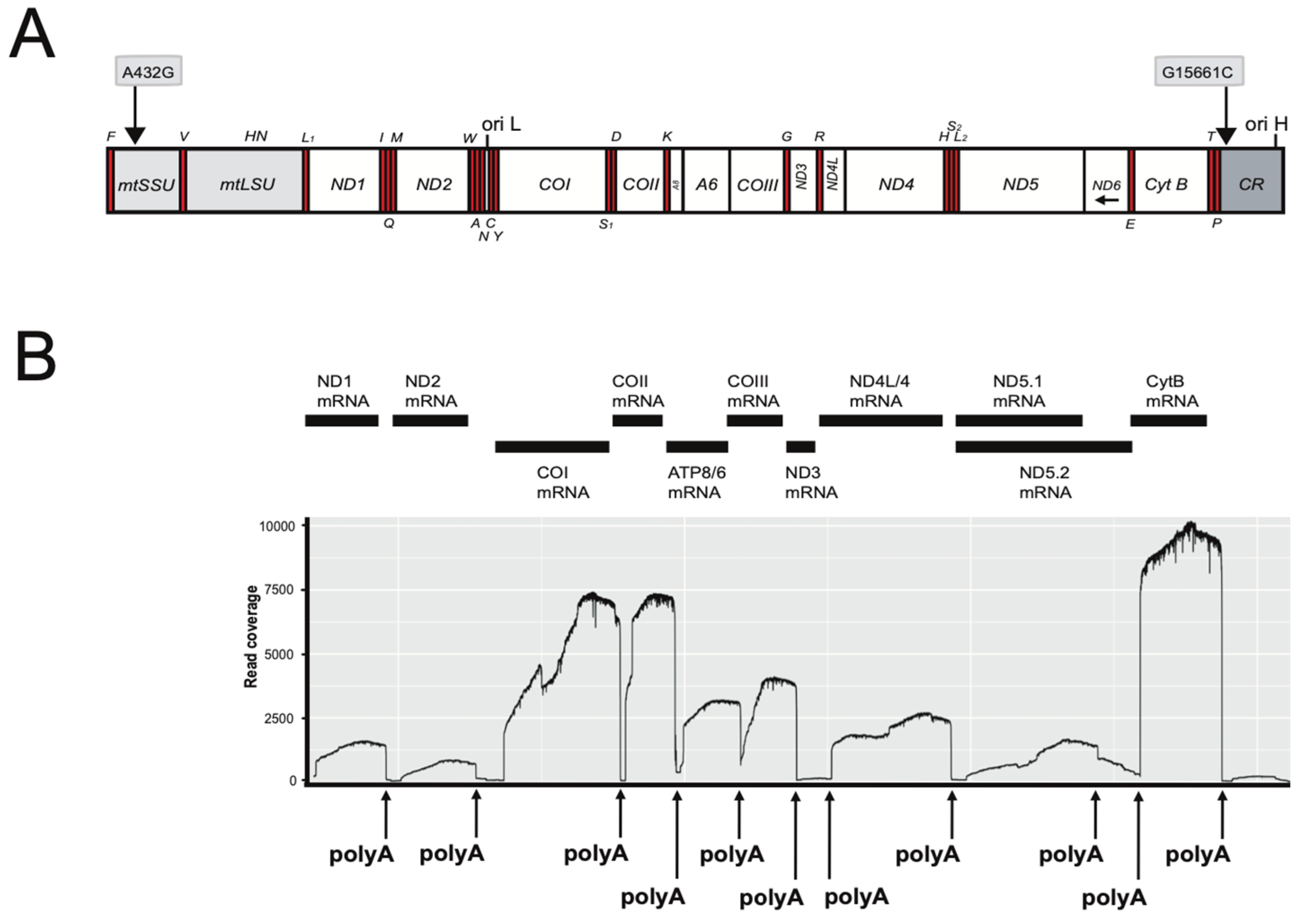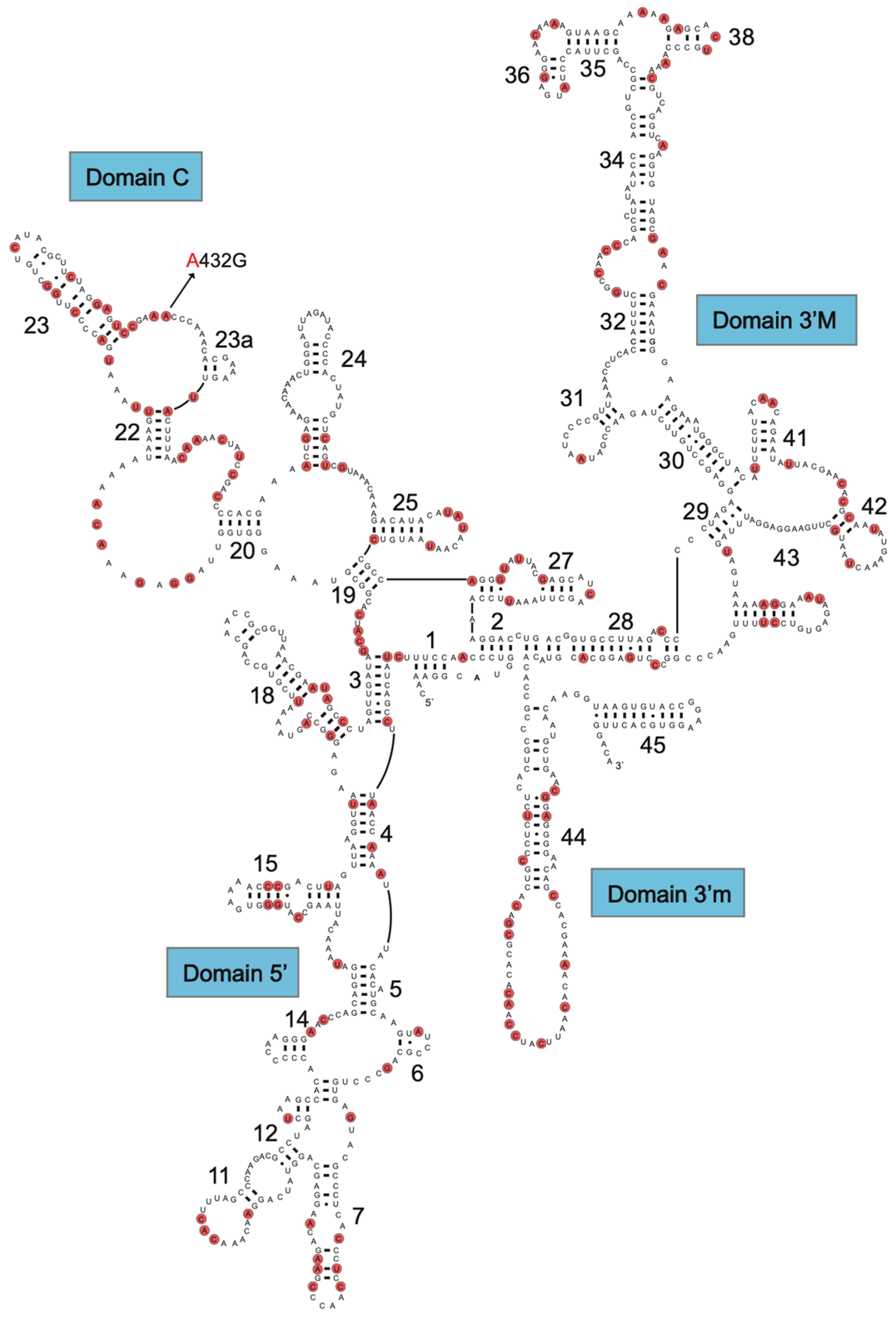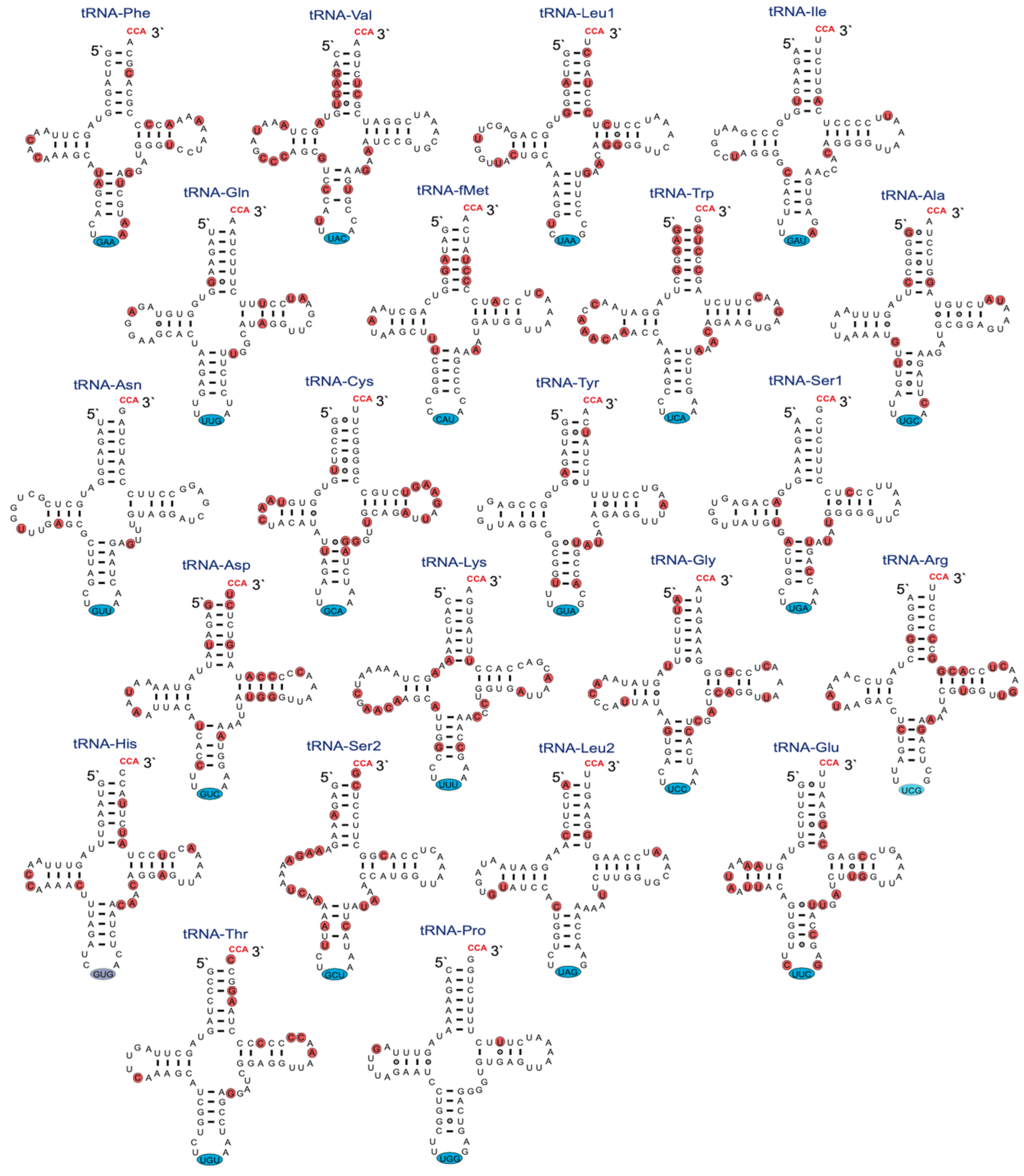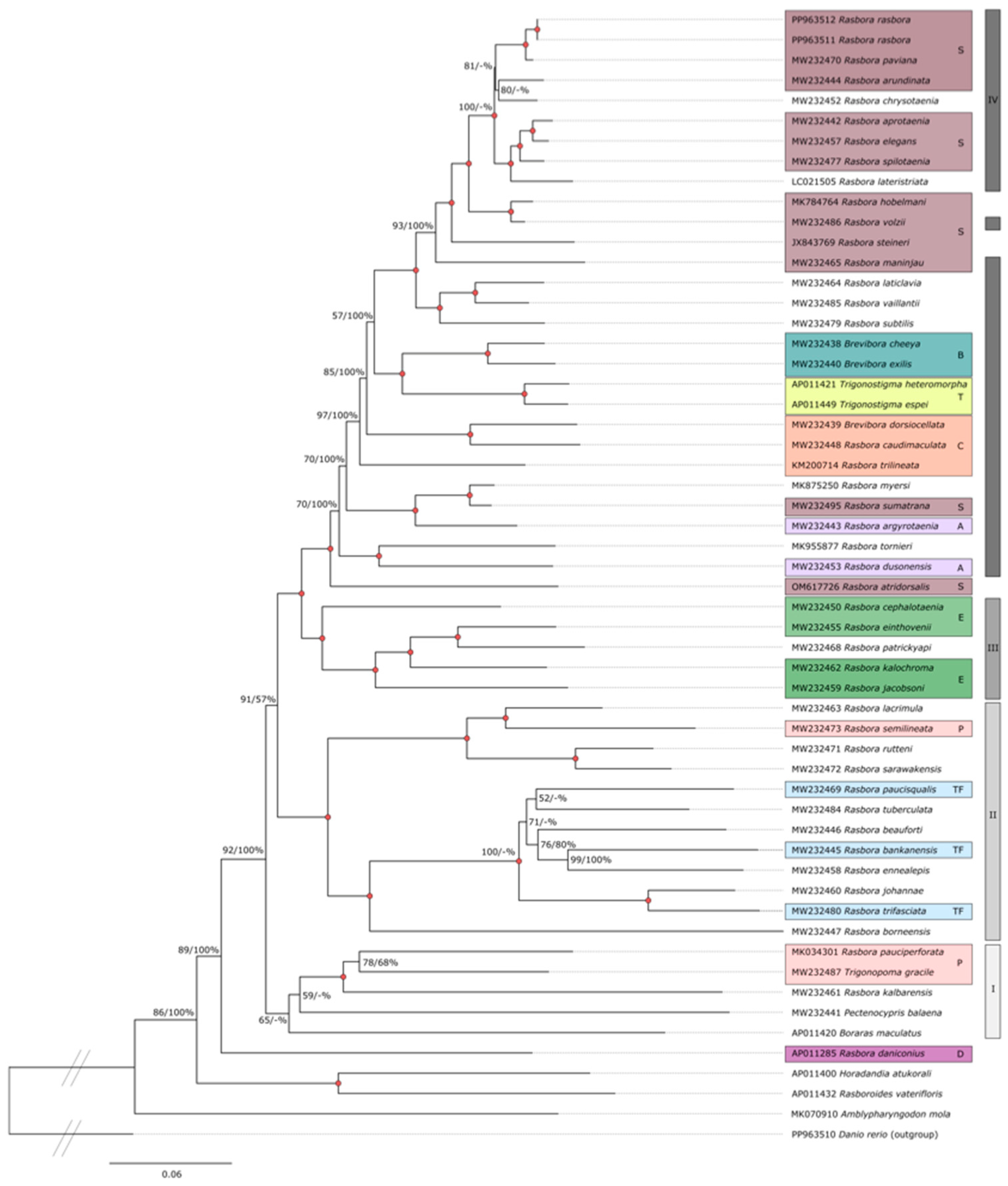Mitogenome, Poly(A) Mitotranscriptome, and Molecular Phylogeny of Rasbora rasbora (Family Danionidae; Subfamily Rasborinae)
Abstract
1. Introduction
2. Materials and Methods
2.1. Tissue Collection and Nucleic Acid Isolation
2.2. DNA and RNA Sequencing
2.3. Mitogenome Assembly and Annotation
2.4. Secondary Structure Predictions of rRNAs and tRNAs
2.5. Phylogenetic Analysis
3. Results
3.1. Mitogenome Sequencing
3.2. The Polyadenylated Mitotranscriptome of R. rasbora
3.3. Comparing RNA Coding Genes of R. rasbora and D. rerio
3.4. Molecular Phylogeny of Subfamily Rasborinae
4. Discussion
5. Conclusions
Supplementary Materials
Author Contributions
Funding
Institutional Review Board Statement
Data Availability Statement
Acknowledgments
Conflicts of Interest
References
- Species by Family/Subfamily. Available online: http://researcharchive.calacademy.org/research/ichthyology/catalog/SpeciesByFamily.asp (accessed on 15 June 2024).
- Eschmeyer’s Catalog of Fishes: Genera, Species, References. Available online: http://researcharchive.calacademy.org/research/ichthyology/catalog/fishcatmain.asp (accessed on 15 June 2024).
- Tang, K.L.; Agnew, M.K.; Hirt, M.V.; Sado, T.; Schneider, L.M.; Freyhof, J.; Sulaiman, Z.; Swartz, E.; Vidthayanon, C.; Miya, M.; et al. Systematics of the subfamily Danioninae (Teleostei: Cypriniformes: Cyprinidae). Mol. Phylogenetics Evol. 2010, 57, 189–214. [Google Scholar] [CrossRef] [PubMed]
- Sholihah, A.; Delrieu-Trottin, E.; Sukmono, T.; Dahruddin, H.; Risdawati, R.; Elvyra, R.; Wibowo, A.; Kustiati, K.; Busson, F.; Sauri, S.; et al. Disentangling the taxonomy of the subfamily Rasborinae (Cypriniformes, Danionidae) in Sundaland using DNA barcodes. Sci. Rep. 2020, 10, 2818. [Google Scholar] [CrossRef] [PubMed]
- Sholihah, A.; Delrieu-Trottin, E.; Sukmono, T.; Dahruddin, H.; Pauzadoux, J.; Tilak, M.K.; Fitriana, Y.; Agnèse, J.F.; Condamine, F.L.; Wowor, D.; et al. Limited dispersal and in situ diversification drive the evolutionary history of Rasborinae fishes in Sundaland. J. Biogeogr. 2021, 48, 2153–2173. [Google Scholar] [CrossRef]
- Liao, T.Y.; Kullander, S.O.; Fang, F. Phylogenetic analysis of the genus Rasbora (Teleostei: Cyprinidae). Zool. Scr. 2010, 39, 155–176. [Google Scholar] [CrossRef]
- Kottelat, M.; Vidthayanon, M.K.C. Boraras micros, a new genus and species of minute freshwater fish from Thailand (Teleostei: Cyprinidae). Ichthyol. Explor. Freshw. 1993, 4, 161–176. [Google Scholar]
- Boore, J.L. Animal mitochondrial genomes. Nucleic Acids Res. 1999, 27, 1767–1780. [Google Scholar] [CrossRef] [PubMed]
- Miya, M.; Nishida, M. Use of mitogenomic information in teleostean molecular phylogenetics: A tree-based exploration under the maximum-parsimony optimality criterion. Mol. Phylogenetics Evol. 2000, 17, 437–455. [Google Scholar] [CrossRef]
- Iwasaki, W.; Fukunaga, T.; Isagozawa, R.; Yamada, K.; Maeda, Y.; Satoh, T.P.; Sado, T.; Mabuchi, K.; Takeshima, H.; Miya, M.; et al. MitoFish and MitoAnnotator: A mitochondrial genome database of fish with an accurate and automatic annotation pipeline. Mol. Biol. Evol. 2013, 30, 2531–2540. [Google Scholar] [CrossRef] [PubMed]
- Inoue, J.G.; Miya, M.; Tsukamoto, K.; Nishida, M. A mitogenomic perspective on the basal teleostean phylogeny: Resolving higher-level relationships with longer DNA sequences. Mol. Phylogenetics Evol. 2001, 20, 275–285. [Google Scholar] [CrossRef]
- Miya, M.; Takeshima, H.; Endo, H.; Ishiguro, N.D.; Inoue, J.G.; Mukai, T.; Satoh, T.P.; Yamaguchi, M.; Kawaguchi, A.; Mabuchi, K.; et al. Major patterns of higher phylogenies: A new perspective based on 100 complete mitochondrial DNA sequences. Mol. Phylogenetics Evol. 2003, 26, 121–138. [Google Scholar] [CrossRef]
- Satoh, T.P.; Sado, T.; Mayden, R.L.; Hanzawa, N.; Nakamura, K.; Nishida, M.; Miya, M. Mitogenomic evolution and interrelationships of the Cypriniformes (Actinopterygii: Ostariophysi): The first evidence toward resolution of higher-level relationships of the world’s largest freshwater fish clade based on 59 whole mitogenome sequences. J. Mol. Evol. 2006, 63, 826–841. [Google Scholar] [CrossRef] [PubMed]
- Miya, M.; Pietsch, T.W.; Orr, J.W.; Arnold, R.J.; Satoh, T.P.; Shedlock, A.M.; Ho, H.C.; Shimazaki, M.; Yabe, M.; Nishida, M. Evolutionary history of anglerfishes (Teleostei: Lophiiformes): A mitogenomic perspective. BMC Evol. Biol. 2010, 10, 58. [Google Scholar] [CrossRef] [PubMed]
- Satoh, T.P.; Miya, M.; Mabuchi, K.; Nishida, M. Structure and variation of the mitochondrial genome of fishes. BMC Genom. 2016, 17, 719. [Google Scholar] [CrossRef]
- Breines, R.; Ursvik, A.; Nymark, M.; Johansen, S.D.; Coucheron, D.H. Complete mitochondrial genome sequences of the Arctic Ocean codfishes Arctogadus glacialis and Boreogadus saida reveal oriL and tRNA gene duplications. Polar Biol. 2008, 31, 1245–1252. [Google Scholar] [CrossRef]
- Coucheron, D.H.; Nymark, M.; Breines, R.; Karlsen, B.O.; Andreassen, M.; Jørgensen, T.E.; Moum, T.; Johansen, S.D. Characterization of mitochondrial mRNA in codfish reveals unique features compared to mammals. Curr. Genet. 2011, 57, 213–222. [Google Scholar] [CrossRef]
- Flynn, T.; Signal, B.; Johnson, S.L.; Gemmell, N.J. Mitochondrial genome diversity among six laboratory zebrafish (Danio rerio) strains. Mitochondrial DNA A 2016, 27, 4364–4371. [Google Scholar] [CrossRef] [PubMed]
- Quispe-Tintaya, W.; White, R.R.; Popov, V.N.; Vijg, J.; Maslov, A.Y. Fast mitochondrial DNA isolation from mammalian cells for next-generation sequencing. Biotechniques 2013, 55, 133–136. [Google Scholar] [CrossRef]
- Bekaert, B.; Ellerington, R.; Van den Abbeele, L.; Decorte, R. In-solution hybridization for the targeted enrichment of the whole mitochondrial genome. Methods Mol. Biol. 2016, 1420, 173–183. [Google Scholar] [CrossRef]
- Senovska, A.; Drozdova, E.; Vaculik, O.; Pardy, F.; Brzobohata, K.; Fialova, D.; Smerda, J.; Kos, P. Cost-effective straightforward method for captured whole mitogenome sequencing of ancient DNA. Forensic Sci. Int. 2021, 319, 110638. [Google Scholar] [CrossRef]
- Zascavage, R.R.; Hall, C.L.; Thorson, K.; Mahmoud, M.; Sedlazeck, F.J.; Planz, J.V. Approaches to whole mitochondrial genome sequencing in the Oxford Nanopore MinION. Curr. Protoc. Hum. Genet. 2019, 104, e94. [Google Scholar] [CrossRef]
- Nanopore Sequencing Accuracy. Available online: https://nanoporetech.com/platform/accuracy (accessed on 15 June 2024).
- Maude, H.; Davidson, M.; Charitakis, N.; Diaz, L.; Bowers, W.H.T.; Gradovich, E.; Andrew, T.; Huntley, D. NUMT confounding biases mitochondrial heteroplasmy calls in favor of the reference. Front. Cell Dev. Biol. 2019, 7, 201. [Google Scholar] [CrossRef]
- Deng, Y.; Qian, Y.; Meng, M.; Jiang, H.; Dong, Y.; Fang, C.; He, S.; Yang, L. Extensive sequence divergence between the reference genomes of two zebrafish strains, Tuebingen and AB. Mol. Ecol. Resour. 2021, 22, 2148–2157. [Google Scholar] [CrossRef]
- Chernyavskaya, Y.; Zhang, X.; Liu, J.; Blackburn, J. Long-read sequencing of the zebrafish genome reorganizes genomic architecture. BMC Genom. 2022, 23, 116. [Google Scholar] [CrossRef]
- Bakke, I.; Johansen, S. Characterization of mitochondrial ribosomal RNA genes in gadiformes: Sequence variations, secondary structural features, and phylogenetic implications. Mol. Phylogenetics Evol. 2002, 25, 87–100. [Google Scholar] [CrossRef]
- Jørgensen, T.E.; Karlsen, B.O.; Emblem, Å.; Breines, R.; Andreassen, M.; Rounge, T.B.; Nederbragt, A.J.; Jakobsen, K.S.; Nymark, M.; Ursvik, A.; et al. Mitochondrial genome variation of Atlantic cod. BMC Res. Notes 2018, 11, 397. [Google Scholar] [CrossRef]
- Dubin, A.; Jørgensen, T.E.; Jakt, L.M.; Johansen, S.D. The mitochondrial transcriptome of the anglerfish Lophius piscatorius. BMC Res. Notes 2019, 12, 800. [Google Scholar] [CrossRef]
- Tamura, K.; Stecher, G.; Kumar, S. MEGA11: Molecular Evolutionary Genetics Analysis Version 11. Mol. Biol. Evol. 2021, 38, 3022–3027. [Google Scholar] [CrossRef]
- Huelsenbeck, J.P.; Ronquist, F. MRBAYES: Bayesian inference of phylogenetic trees. Bioinformatics 2001, 17, 754–755. [Google Scholar] [CrossRef]
- Lumbantobing, D.N. Four new species of Rasbora of the Sumatrana group (Teleostei: Cyprinidae) from norther Sumatra, Indonesia. Zootaxa 2014, 3764, 1–25. [Google Scholar] [CrossRef]
- Antunes, A.; Ramos, M.J. Discovery of a large number of previously unrecognized mitochondrial pseudogenes in fish genomes. Genomics 2005, 86, 708–717. [Google Scholar] [CrossRef][Green Version]
- Bai, Y.; Shakeley, R.M.; Attardi, G. Tight control of respiration by NADH dehydrogenase ND5 subunit gene expression in mouse mitochondria. Mol. Cell Biol. 2000, 20, 805–815. [Google Scholar] [CrossRef]
- Das, S.; Ferlito, M.; Kent, O.A.; Fox-Talbot, K.; Wang, R.; Liu, D.; Raghavachari, N.; Yang, Y.; Wheelan, S.J.; Murphy, E.; et al. Nuclear miRNA regulates the mitochondrial genome in the heart. Circ. Res. 2012, 110, 1596–1603. [Google Scholar] [CrossRef]
- Das, S.; Bedja, D.; Campbell, N.; Dunkerly, B.; Chenna, V.; Maitra, A.; Steenbergen, C. miR-181c regulates the mitochondrial genome, bioenergetics, and propensity for heart failure in vivo. PLoS ONE 2014, 9, e96820. [Google Scholar] [CrossRef]
- Akiyoshi, K.; Boersma, G.J.; Johnson, M.D.; Velasquez, F.C.; Dunkerly-Eyring, B.; O’Brien, S.; Yamaguchi, A.; Steenbergen, C.; Tamashiro, K.L.K.; Das, S. Role of miR-181c in diet-induced obesity through regulation of lipid synthesis in liver. PLoS ONE 2021, 16, e0256973. [Google Scholar] [CrossRef]
- Collins, R.A.; Armstrong, K.F.; Meier, R.; Yi, Y.; Brown, S.D.; Cruickshank, R.H.; Keeling, S.; Johnston, C. Barcoding and border biosecurity: Identifying cyprinid fishes in the aquarium trade. PLoS ONE 2012, 7, e28381. [Google Scholar] [CrossRef]




| mRNA 1 | 3′ End 2 |
|---|---|
| ND1 | CAA CUA UAA CCAAaaaaaaaaaa |
| ND2 | ACC ACC Uaa aaaaaaaa |
| ND3 | GCA GAA Uaa aaaaaaaa |
| ND4L/ND4 | UGU UAU UAa aaaaaaaaa |
| ND5 (alt 1) | AUC CUC UAA ACUGAaaaaaaaaaa |
| ND5 (alt 2) 3 | AUC CUC UAA [a-ND6][a-tRNA-E] AUAUUUUUAaaaaaaaaaa |
| ND6 4 | No polyadeny lation |
| CytB | CGG GAC Uaa aaaaaaaa |
| COI | CCA AAC UAA [a-tRNA-S1] Aaaaaaaaaaa |
| COII | GAC GCC Uaa aaaaaaaa |
| COIII | GGC UCA UAa aaaaaaaaa |
| A8/A6 5 | AAC ACC UAa aaaaaaaaa |
Disclaimer/Publisher’s Note: The statements, opinions and data contained in all publications are solely those of the individual author(s) and contributor(s) and not of MDPI and/or the editor(s). MDPI and/or the editor(s) disclaim responsibility for any injury to people or property resulting from any ideas, methods, instructions or products referred to in the content. |
© 2024 by the authors. Licensee MDPI, Basel, Switzerland. This article is an open access article distributed under the terms and conditions of the Creative Commons Attribution (CC BY) license (https://creativecommons.org/licenses/by/4.0/).
Share and Cite
Profant, S.W.; Jørgensen, T.E.; Austad, E.; Babiak, I.; Johansen, S.D. Mitogenome, Poly(A) Mitotranscriptome, and Molecular Phylogeny of Rasbora rasbora (Family Danionidae; Subfamily Rasborinae). Fishes 2024, 9, 317. https://doi.org/10.3390/fishes9080317
Profant SW, Jørgensen TE, Austad E, Babiak I, Johansen SD. Mitogenome, Poly(A) Mitotranscriptome, and Molecular Phylogeny of Rasbora rasbora (Family Danionidae; Subfamily Rasborinae). Fishes. 2024; 9(8):317. https://doi.org/10.3390/fishes9080317
Chicago/Turabian StyleProfant, Stanislava Wolf, Tor Erik Jørgensen, Eirik Austad, Igor Babiak, and Steinar Daae Johansen. 2024. "Mitogenome, Poly(A) Mitotranscriptome, and Molecular Phylogeny of Rasbora rasbora (Family Danionidae; Subfamily Rasborinae)" Fishes 9, no. 8: 317. https://doi.org/10.3390/fishes9080317
APA StyleProfant, S. W., Jørgensen, T. E., Austad, E., Babiak, I., & Johansen, S. D. (2024). Mitogenome, Poly(A) Mitotranscriptome, and Molecular Phylogeny of Rasbora rasbora (Family Danionidae; Subfamily Rasborinae). Fishes, 9(8), 317. https://doi.org/10.3390/fishes9080317






